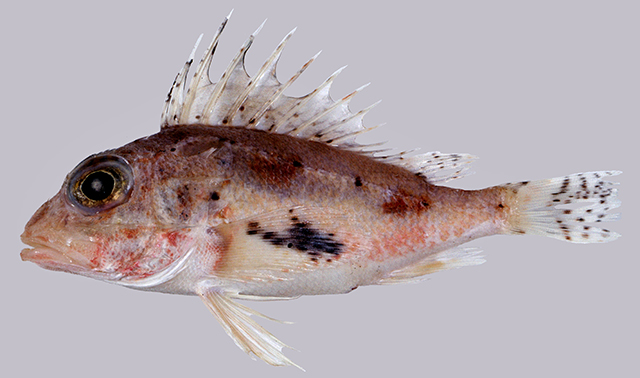| Neosebastidae (Gurnard scorpionfishes) |
| 17 cm SL (male/unsexed) |
|
demersal; marine; depth range 138 - 270 m |
| Western Pacific: Off northeastern coast of Queensland, Australia. |
|
Dorsal spines (total): 8-8; Dorsal soft rays (total): 8-8; Anal spines: 3-3; Anal soft rays: 5-5. Diagnosis: Underside of mandible with numerous tiny pores, no ridges. Preocular spine usually divided into 2 points, and flattened anteriorly and posteriorly. There are no additional spines between lacrimal and suborbital ridges. Upper opercular spine usually simple. Midinterorbital space usually covered with scales. Pored lateral-line scales 30-35 (mode 32); longitudinal scale rows 49-57 (52). Pectoral-fin rays 20-22 (21); pectoral fin long (2.6-3.0, mean 2.8 in SL), reaching or extending beyond a vertical at origin of last dorsal-fin spine. Posterior margin of maxilla not reaching a vertical at posterior margin of pupil. Interorbital width wide (5.5-7.1, 6.4 in HL). Bilobed portion of swimbladder approximately equal to half of total swim bladder length. There are numerous distinct small black spots on lateral line and posterior part of eye (spots absent in juveniles less than 50 mm SL); 1 or 2 large dark spots on cleithral spine (Ref. 54394). |
| Found on the continental shelf and continental slope (Ref. 75154). Juveniles less than 6.1 cm SL were caught at depths of 70 - 110 meters. Most specimens have sand grains inside the mouth indicating occurrence on open, predominantly sandy substrata (Ref. 54394). |
|
Not Evaluated (N.E.) Ref. (130435)
|
| harmless |
Source and more info: www.fishbase.org. For personal, classroom, and other internal use only. Not for publication.
